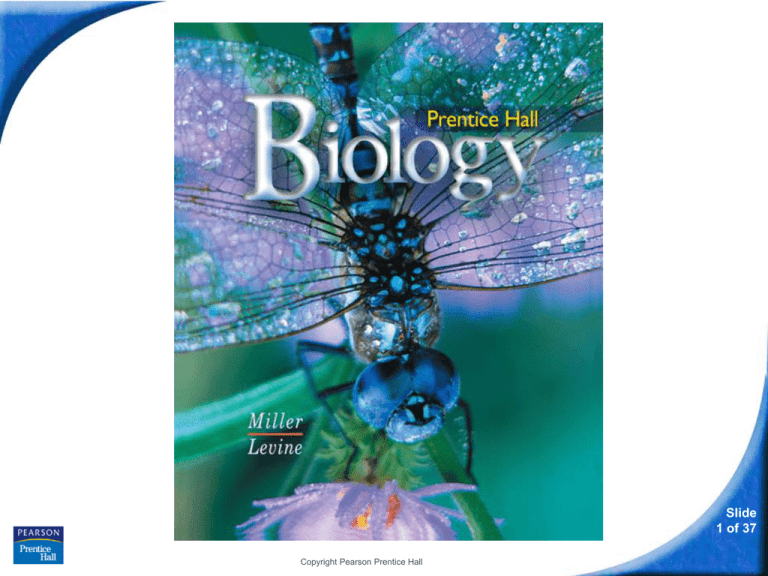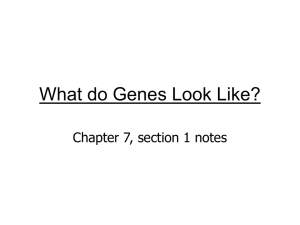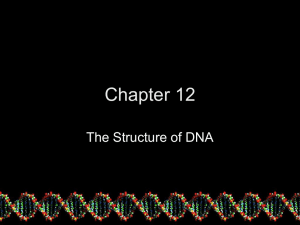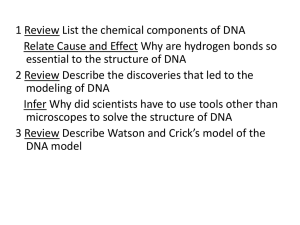
Biology
Slide
1 of 37
Copyright Pearson Prentice Hall
Chapter 12 DNA
Slide
2 of 37
Copyright Pearson Prentice Hall
12–1 DNA
Avery and DNA
What did scientists discover about the
relationship between genes and DNA?
Slide
3 of 37
Copyright Pearson Prentice Hall
12–1 DNA
Avery and DNA
Scientists discovered that the nucleic
acid DNA stores and transmits the
genetic information from one generation
of an organism to the next.
Slide
4 of 37
Copyright Pearson Prentice Hall
12–1 DNA
The Components and Structure of DNA
What is the overall structure of the DNA
molecule?
Slide
5 of 37
Copyright Pearson Prentice Hall
12–1 DNA
The Components and Structure of DNA
The Components and Structure of DNA
DNA is made up of nucleotides.
A nucleotide is a monomer of nucleic acids made
up of a five-carbon sugar called deoxyribose, a
phosphate group, and a nitrogenous base.
Slide
6 of 37
Copyright Pearson Prentice Hall
The Components and Structure of DNA
There are four
kinds of bases in
in DNA:
• adenine
• guanine
• cytosine
• thymine
Slide
7 of 37
Copyright Pearson Prentice Hall
The Components and Structure of DNA
The backbone of a DNA chain is formed by sugar
and phosphate groups of each nucleotide.
The nucleotides can be joined together in any order.
Slide
8 of 37
Copyright Pearson Prentice Hall
12–1 DNA
The Components and Structure of DNA
Chargaff's Rules
Erwin Chargaff discovered that:
• The percentages of guanine [G] and cytosine
[C] bases are almost equal in any sample of
DNA.
• The percentages of adenine [A] and thymine
[T] bases are almost equal in any sample of
DNA.
Slide
9 of 37
Copyright Pearson Prentice Hall
12–1 DNA
The Components and Structure of DNA
The Double Helix
Using clues from other scientists, James
Watson and Francis Crick built a model that
explained how DNA carried information and
could be copied.
Watson and Crick's model of DNA was a
double helix, in which two strands were
wound around each other.
Slide
10 of 37
Copyright Pearson Prentice Hall
The Components and Structure of
DNA
DNA Double Helix
Slide
11 of 37
Copyright Pearson Prentice Hall
The Components and Structure of
DNA
Watson and Crick discovered that hydrogen bonds
can form only between certain base pairs—adenine
and thymine, and guanine and cytosine.
This principle is called base pairing.
Slide
12 of 37
Copyright Pearson Prentice Hall
12–1
DNA is a long molecule made of monomers
called
a. nucleotides.
b. purines.
c. pyrimidines.
d. sugars.
Slide
13 of 37
Copyright Pearson Prentice Hall
12–1
Chargaff's rules state that the number of
guanine nucleotides must equal the number of
a. cytosine nucleotides.
b. adenine nucleotides.
c. thymine nucleotides.
d. thymine plus adenine nucleotides.
Slide
14 of 37
Copyright Pearson Prentice Hall
12–1
In DNA, the following base pairs occur:
a. A with C, and G with T.
b. A with T, and C with G.
c. A with G, and C with T.
d. A with T, and C with T.
Go to Section 12-2
Slide
15 of 37
Copyright Pearson Prentice Hall







